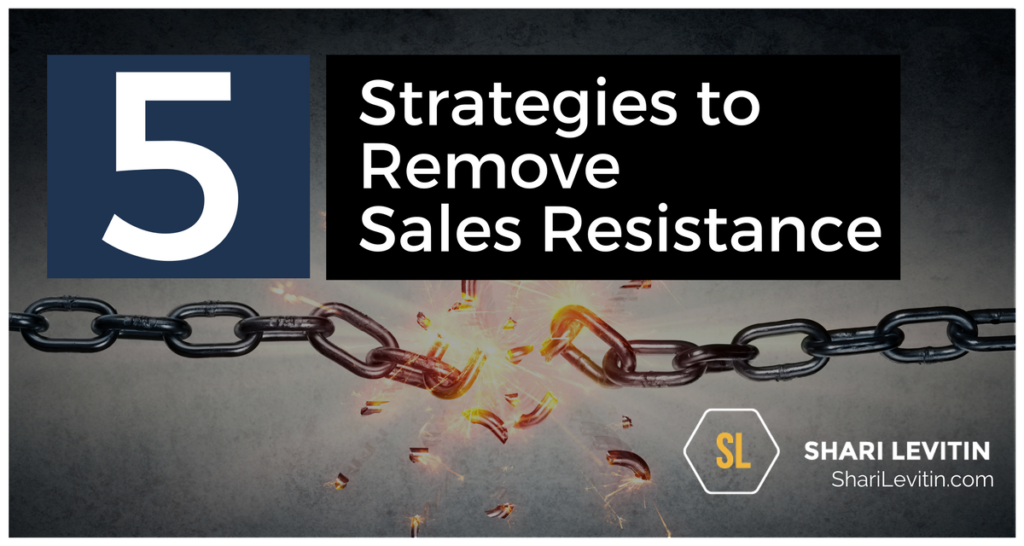People have resisted salespeople since the beginning of time. Just as salespeople have a default mode, prospects do, too. Their automatic response is to say, “No way, José.”
Face it. People don’t want to be sold. This sentiment is increasing as we live more of our lives online. According to Terry Jones, founder of kayak.com, 98% of all college students would rather purchase online. They avoid salespeople at all costs.
As Mike Weinberg says in New Sales Simplified: the fact that customers have sales resistance isn’t your fault, but it is your problem.
Fortunately, it is a problem that the right training can solve. Here’s how:
#1: Define What Concessions You’re Willing to Make in Advance.
What concessions are you willing to make? You had better know before heading into the close, before your adrenaline kicks in. In the heat of the moment, you might throw in your dog and the kitchen sink before you’ve thought through the financial ramifications of your new offer.
Clearly define discounts, upgrades, and incentives in advance of any negotiation. How far can you go? How far should you go? Plan what the customer will give you in return.
Don’t offer discounts and ask for nothing in return.
[Tweet “Knowing WHAT you’ll concede and WHEN you will concede are two different things. #HeartAndSell #SalesTips”]
Remember: knowing what you’ll concede and when you will concede are two different things. You are always better off starting with smaller concessions, and offering bigger ones as your negotiations progress. Never say, “Take it or leave it,” unless you really are willing to walk away. By pre-planning, you will close more deals and appear stronger and more confident to your customer.
#2: Summarize Your Offer
After I demonstrate my product to customers, I like to ask them to articulate how they feel about it. “What do you like about what I’ve shown you so far?” Ask this question aside from the obvious impediment of price: “Assuming the numbers work, what do you like about what I’ve shown you so far?” Make sure to ask everyone who is present. They may tell you what they like, or they may give you an objection. Either way, they’ll arm you with valuable information.
#3: Don’t Lead with Incentives
When you lead with incentives, you lose credibility—particularly if your customer isn’t already sold. You just sound desperate, which makes the customer wonder what’s wrong with your product…or with you. The other day, I walked into a boating store to kill time while my son was next door at a karate class. The salesman offered to throw in water skis and a wetsuit if I purchased his boat by the weekend. Problem? The water skis sounded cool and the wetsuit would be good for diving, but I wasn’t sold on the $55,000 boat, so the bonus meant nothing to me.
#4: Don’t Send a Proposal or Create a Contract Until ALL of the Terms Are Agreed Upon by All of the Stakeholders
I bet you’ve heard this before: “Send me a proposal,” or “Put it in writing.” These statements can be an excuse. Solidify all the terms of your deal with all relevant decision-makers before committing anything to writing. If you don’t, your client may change his mind or change the deal, leaving you with little wiggle room.
Also, sometimes when people ask for a proposal in writing, it’s because they really want to just get you off the phone without hurting your feelings. If you sense that’s what’s happening, ask. If you think about selling as a quest for the truth, finding out how your prospect really feels is essential. Otherwise you’ll be writing a whole lot of proposals that no one will ever read.
#5: Save a Valuable Piece of Information For Last
Depending on your product, you may not want to show your customers everything! You’ve heard of saving the best for last? When you save a valuable piece of information—for example, a unique service add-on—you’re holding onto a negotiation tool you may very well need.
Remember: customers are taught to say “no” before they say “yes.” Unfortunately, most sales reps respond by dropping price. When you refrain from showing something valuable, you have the upper hand in the negotiation.
Ask yourself, what adds value besides price?
- Incentives
- VIP service
- Extended warranty
- Bonus program
- Increased usage
When your customer asks for a discount, you can respond by asking which incentive he’s willing to give up.
To learn more get your copy of the bestseller book by Shari Levitin: Heart and Sell on Amazon.
